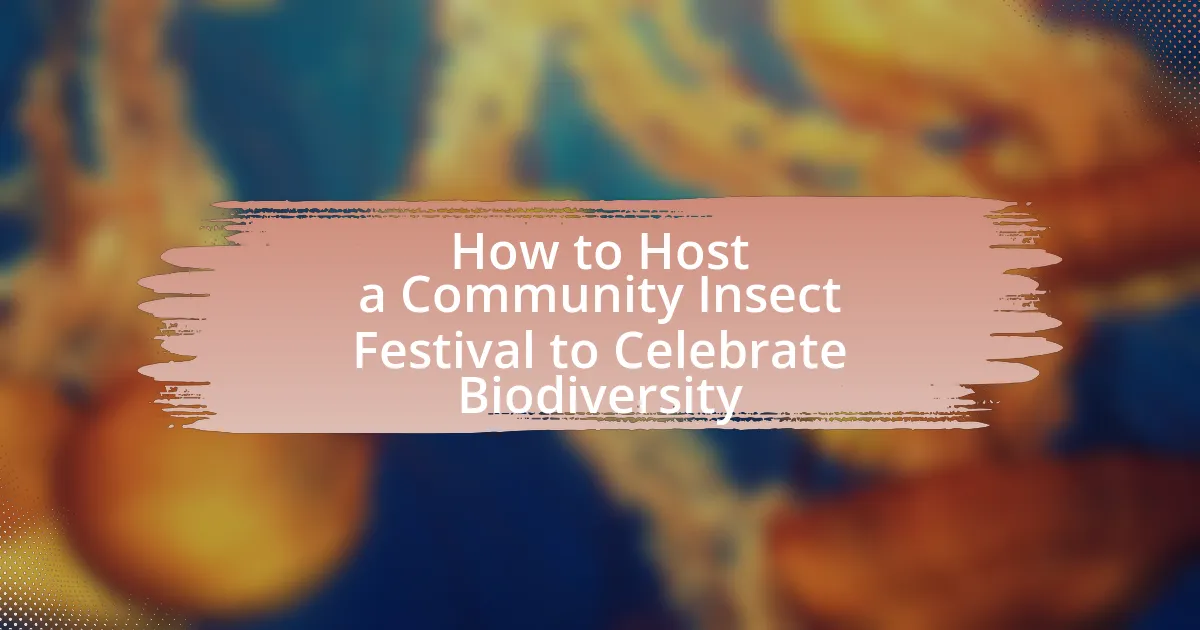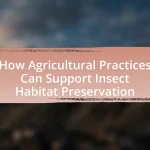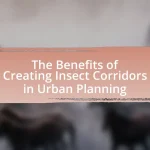A Community Insect Festival is an event aimed at celebrating and educating the public about the vital role insects play in ecosystems and biodiversity. The article outlines the importance of biodiversity, the impact of insects on ecological health, and the key components necessary for organizing a successful festival, including educational programming, community engagement, and diverse activities. It also details practical steps for planning the festival, such as securing permits, selecting a suitable location, and promoting community involvement. Additionally, the article highlights effective marketing strategies and best practices to ensure the festival’s success while addressing potential challenges that may arise during the planning and execution phases.
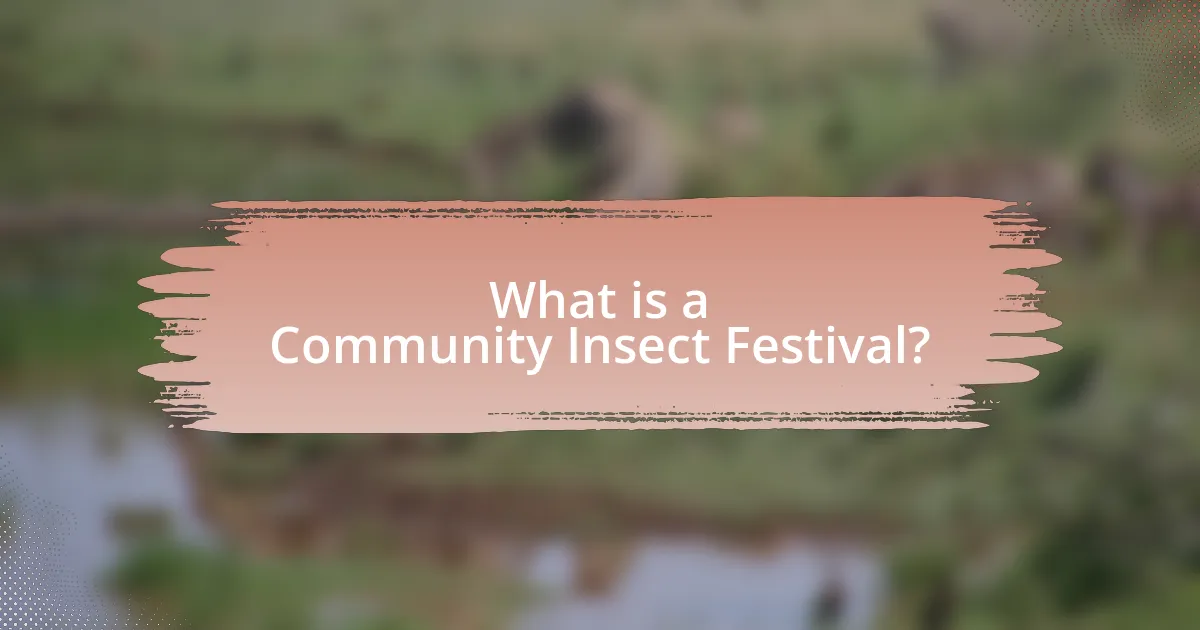
What is a Community Insect Festival?
A Community Insect Festival is an event designed to celebrate and educate the public about the importance of insects in the ecosystem. These festivals typically feature activities such as insect exhibits, educational workshops, and interactive displays that highlight the role of insects in biodiversity, pollination, and food chains. The festivals aim to foster appreciation for insects and promote conservation efforts, often supported by local environmental organizations and educational institutions.
Why is celebrating biodiversity important?
Celebrating biodiversity is important because it fosters awareness and appreciation of the variety of life forms on Earth, which is essential for ecosystem health and resilience. Biodiversity contributes to ecosystem services such as pollination, nutrient cycling, and climate regulation, which are vital for human survival. For instance, a study published in the journal “Nature” found that ecosystems with higher biodiversity are more productive and better able to withstand environmental stressors. By celebrating biodiversity, communities can promote conservation efforts, enhance local economies through ecotourism, and encourage sustainable practices that protect natural habitats.
How does biodiversity impact ecosystems?
Biodiversity significantly impacts ecosystems by enhancing their resilience, productivity, and stability. Diverse species contribute to various ecological functions, such as nutrient cycling, pollination, and pest control, which are essential for maintaining ecosystem health. For instance, ecosystems with a higher number of plant species can better withstand environmental stressors like drought or disease, as different species may respond differently to these challenges. Research indicates that ecosystems with greater biodiversity can produce up to 50% more biomass than those with lower diversity, demonstrating the direct correlation between species variety and ecosystem productivity.
What role do insects play in biodiversity?
Insects play a crucial role in biodiversity by serving as pollinators, decomposers, and a food source for various organisms. Pollination by insects, such as bees and butterflies, is essential for the reproduction of many flowering plants, which in turn supports entire ecosystems. For instance, approximately 75% of the world’s food crops depend on insect pollination, highlighting their importance in maintaining plant diversity and agricultural productivity. Additionally, insects contribute to nutrient cycling by breaking down organic matter, which enriches soil and promotes plant growth. This process supports a diverse range of species, creating a balanced ecosystem. Furthermore, insects are a primary food source for birds, mammals, and other wildlife, thus sustaining higher trophic levels and enhancing overall biodiversity.
What are the key components of a successful insect festival?
The key components of a successful insect festival include educational programming, diverse activities, community engagement, and sustainable practices. Educational programming, such as workshops and presentations, informs attendees about insect biodiversity and ecology, fostering awareness and appreciation. Diverse activities, including insect-themed games, art installations, and cooking demonstrations featuring edible insects, cater to various interests and age groups, enhancing participation. Community engagement is crucial; involving local schools, organizations, and businesses can increase attendance and support. Lastly, implementing sustainable practices, such as waste reduction and promoting local ecosystems, aligns the festival with environmental values, making it a model for biodiversity celebration.
What activities can be included in the festival?
Activities that can be included in the festival are insect-themed workshops, educational talks, guided nature walks, and interactive exhibits. Insect-themed workshops can teach participants about insect habitats and life cycles, while educational talks can feature experts discussing the importance of biodiversity. Guided nature walks allow attendees to observe insects in their natural environment, enhancing their understanding of local ecosystems. Interactive exhibits can engage visitors with hands-on experiences, such as insect identification stations and live insect displays, promoting awareness and appreciation for biodiversity.
How can educational programs enhance the festival experience?
Educational programs can enhance the festival experience by providing attendees with interactive learning opportunities about biodiversity and the role of insects in ecosystems. These programs can include workshops, guided nature walks, and expert talks that engage participants and deepen their understanding of ecological concepts. For instance, studies show that hands-on educational activities increase retention of information and foster a greater appreciation for environmental issues. By integrating educational elements, festivals can transform into platforms for awareness and advocacy, ultimately enriching the overall experience for attendees.
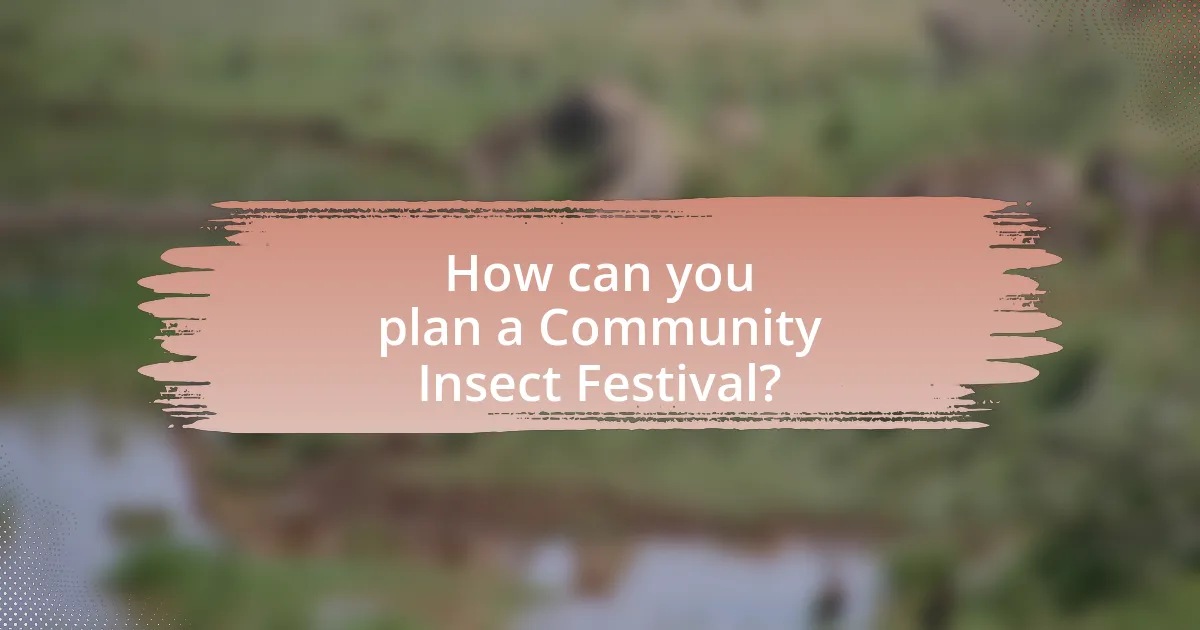
How can you plan a Community Insect Festival?
To plan a Community Insect Festival, first establish a clear objective that focuses on celebrating biodiversity and educating the community about insects. Next, select a suitable date and location that can accommodate various activities, such as workshops, exhibits, and food stalls. Collaborate with local schools, environmental organizations, and entomologists to provide educational content and activities, ensuring a diverse range of insect-related topics are covered. Promote the festival through social media, local newspapers, and community boards to attract attendees. Finally, ensure that all necessary permits are obtained and that safety measures are in place to create an enjoyable experience for all participants.
What steps are involved in organizing the festival?
The steps involved in organizing a community insect festival to celebrate biodiversity include defining the festival’s purpose, securing a venue, obtaining necessary permits, assembling a planning committee, creating a budget, scheduling activities, promoting the event, and coordinating logistics. Each step is crucial for ensuring the festival’s success and alignment with its goal of raising awareness about biodiversity. For instance, securing a venue typically requires checking availability and suitability for the expected number of attendees, while obtaining permits ensures compliance with local regulations.
How do you choose a suitable location for the festival?
To choose a suitable location for the festival, assess factors such as accessibility, space availability, and environmental suitability. Accessibility ensures that attendees can easily reach the venue, which is crucial for maximizing participation; for example, a location near public transportation can significantly increase attendance rates. Space availability is essential to accommodate various activities, vendors, and attendees comfortably, with a recommended minimum area of 1,000 square feet for small festivals. Environmental suitability involves selecting a site that supports biodiversity, such as parks or nature reserves, which can enhance the festival’s theme and provide a natural backdrop.
What permits or permissions are needed for hosting the event?
To host a community insect festival, you typically need a special event permit from the local government or municipality. This permit ensures compliance with local regulations regarding public gatherings, safety, and noise control. Additionally, if the event involves food vendors, health permits may be required to ensure food safety standards are met. For events in public parks or spaces, a park use permit may also be necessary. These requirements can vary by location, so it is essential to consult local authorities for specific regulations and guidelines.
How can you engage the community in the festival planning?
Engaging the community in festival planning can be achieved by actively involving local residents in decision-making processes and activities. Organizing workshops and focus groups allows community members to share their ideas and preferences, fostering a sense of ownership and investment in the festival. Research indicates that community involvement in event planning increases participation rates and satisfaction, as seen in the 2018 study by the University of Florida, which highlighted that festivals with community input saw a 30% increase in attendance compared to those without. Additionally, utilizing social media platforms to gather feedback and promote volunteer opportunities can further enhance community engagement, ensuring diverse perspectives are represented in the festival’s development.
What strategies can be used to promote community involvement?
To promote community involvement in hosting a Community Insect Festival to celebrate biodiversity, strategies include engaging local schools, collaborating with environmental organizations, and utilizing social media for outreach. Engaging local schools can foster interest among students and families, as educational programs can be integrated into the festival, enhancing participation. Collaborating with environmental organizations can provide resources and expertise, ensuring the festival is informative and impactful. Utilizing social media platforms can effectively reach a broader audience, encouraging community members to participate and share their experiences. These strategies are supported by successful community events that have demonstrated increased attendance and engagement through educational partnerships and effective communication channels.
How can local schools and organizations contribute?
Local schools and organizations can contribute by actively participating in the planning and execution of the Community Insect Festival. Schools can incorporate insect-related educational programs into their curriculum, fostering awareness about biodiversity among students. Organizations can provide resources, volunteers, and sponsorships to support festival activities, such as workshops, exhibits, and insect-related games. For instance, a study by the National Wildlife Federation highlights that community involvement in biodiversity events increases public engagement and education, leading to a greater appreciation for local ecosystems.
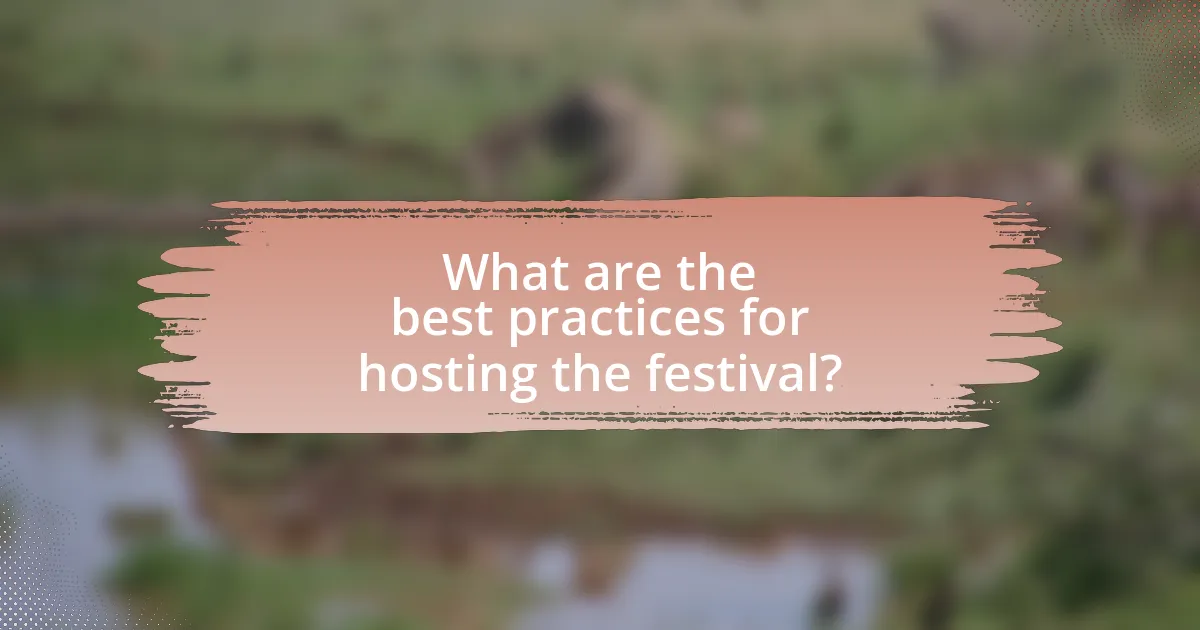
What are the best practices for hosting the festival?
The best practices for hosting a community insect festival to celebrate biodiversity include thorough planning, community engagement, and educational programming. Effective planning involves selecting an accessible venue, securing necessary permits, and establishing a budget that accounts for all expenses. Engaging the community is crucial; this can be achieved by collaborating with local schools, environmental organizations, and entomologists to attract a diverse audience and enhance the festival’s credibility. Educational programming should focus on interactive activities, such as insect identification workshops and presentations on the importance of biodiversity, which can increase awareness and appreciation for local ecosystems. These practices are supported by successful festivals that have demonstrated increased community involvement and educational impact, such as the annual BugFest in North Carolina, which attracts thousands of attendees and emphasizes the significance of insects in our environment.
How can you ensure a diverse range of insect-related activities?
To ensure a diverse range of insect-related activities, organizers should incorporate various educational, interactive, and artistic elements that appeal to different age groups and interests. This can include workshops on insect identification, live demonstrations of insect habitats, art installations inspired by insects, and hands-on activities like building insect hotels. Research indicates that engaging multiple senses and learning styles enhances participation; for instance, a study by the University of Florida found that interactive exhibits increase visitor engagement by 40%. By offering a mix of activities, organizers can cater to a broader audience, fostering a deeper appreciation for insect biodiversity.
What types of insect exhibits can be featured?
Insect exhibits can feature various types, including live insect displays, educational panels on local species, interactive exhibits showcasing insect habitats, and collections of preserved specimens. Live insect displays allow attendees to observe behaviors and interactions, while educational panels provide information on the ecological roles of insects, such as pollination and decomposition. Interactive exhibits can engage visitors by simulating habitats like forests or wetlands, and preserved specimens offer a tangible connection to the diversity of insect life. These types of exhibits collectively enhance understanding of biodiversity and the importance of insects in ecosystems.
How can interactive workshops enhance visitor engagement?
Interactive workshops enhance visitor engagement by actively involving participants in hands-on activities that foster learning and connection. These workshops allow visitors to explore biodiversity through direct interaction with insects, promoting curiosity and deeper understanding. Research indicates that experiential learning, such as that found in interactive workshops, significantly increases retention of information and encourages community participation, as evidenced by studies showing that participants in hands-on educational programs report higher satisfaction and engagement levels compared to traditional lecture formats.
What are effective marketing strategies for the festival?
Effective marketing strategies for a community insect festival include leveraging social media platforms, collaborating with local schools and environmental organizations, and utilizing targeted email campaigns. Social media platforms like Facebook and Instagram can reach a broad audience, allowing for event promotion through engaging content and visuals. Collaborating with local schools can enhance community involvement and attract families, while partnerships with environmental organizations can lend credibility and attract eco-conscious attendees. Targeted email campaigns can effectively reach previous attendees and interested community members, providing them with updates and incentives to participate. These strategies are supported by the fact that social media advertising can increase event visibility by up to 80%, and community partnerships often lead to a 30% increase in attendance at local events.
How can social media be utilized to promote the event?
Social media can be utilized to promote the event by creating engaging content that highlights the festival’s activities, educational opportunities, and unique attractions. Platforms like Facebook, Instagram, and Twitter allow organizers to share visually appealing posts, event countdowns, and interactive stories to generate excitement and reach a broader audience. For instance, using targeted ads can increase visibility among local communities interested in biodiversity and environmental issues, as studies show that social media advertising can boost event attendance by up to 30%. Additionally, leveraging hashtags related to biodiversity and community events can enhance discoverability and encourage user-generated content, further amplifying the event’s reach.
What partnerships can be formed to increase visibility?
Partnerships with local schools, environmental organizations, and businesses can be formed to increase visibility for a community insect festival. Collaborating with schools allows for educational programs and student involvement, which can attract families and enhance community engagement. Partnering with environmental organizations can provide credibility and access to a broader audience interested in biodiversity. Additionally, local businesses can sponsor the event or provide resources, thereby increasing promotional reach through their customer networks. These partnerships leverage existing community structures to amplify visibility and participation in the festival.
What tips can help ensure the festival’s success?
To ensure the festival’s success, effective planning and community engagement are essential. Organizers should establish a clear vision and set specific goals for the festival, such as promoting biodiversity awareness and attracting a diverse audience. Engaging local schools, environmental organizations, and community groups can enhance participation and support. Additionally, providing educational workshops and interactive activities related to insects can foster interest and learning. According to a study by the National Park Service, community involvement in events increases attendance and satisfaction, highlighting the importance of collaboration in event success.
How can feedback be collected to improve future festivals?
Feedback can be collected to improve future festivals through surveys, interviews, and social media engagement. Surveys can be distributed both online and on-site, allowing attendees to provide structured feedback on various aspects of the festival, such as activities, organization, and overall experience. Interviews with participants and vendors can yield in-depth insights into their experiences and suggestions for improvement. Additionally, monitoring social media platforms for comments and reviews can help organizers gauge public sentiment and identify areas needing enhancement. Research indicates that 70% of event organizers utilize post-event surveys to gather feedback, demonstrating the effectiveness of this method in refining future events.
What common challenges should be anticipated and addressed?
Common challenges that should be anticipated and addressed when hosting a community insect festival include logistical issues, public engagement, and educational outreach. Logistical issues may arise from securing permits, coordinating vendors, and managing event space, which can complicate planning and execution. Public engagement is crucial, as attracting attendees and ensuring their participation can be difficult; strategies such as marketing through social media and local partnerships can enhance visibility. Educational outreach is essential to effectively communicate the importance of biodiversity and insects; providing informative materials and interactive activities can help overcome misconceptions and foster appreciation. Addressing these challenges proactively can lead to a successful event that effectively celebrates biodiversity.
